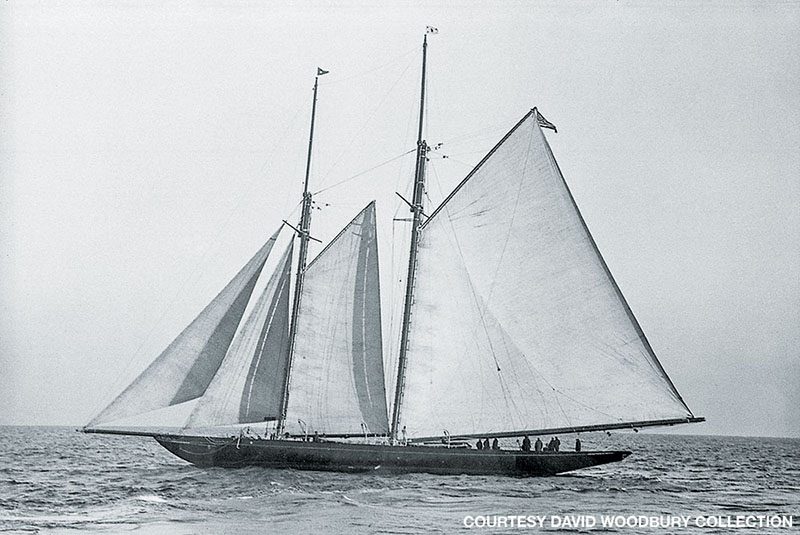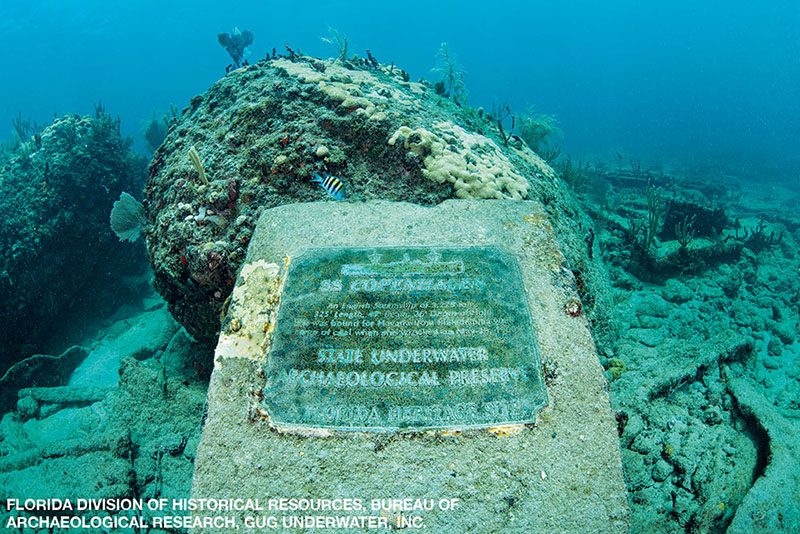Historic shipwrecks allow divers to experience a combination of history, biology and the undersea world. The Half Moon and SS Copenhagen near Miami, Florida, are on the National Register of Historic Places and are among the 12 Florida Underwater Archaeological Preserves around the state. Nominated by local communities, each preserve must have historical importance, plentiful marine life, public accessibility and recognizable features. Half Moon and SS Copenhagen perfectly fit the criteria.
Half Moon was built in 1908 as a German racing yacht, touring a circuit that pit it against the best in the world. SS Copenhagen was a bulk carrier, an early version of a design that would revolutionize maritime trade. Located in relatively shallow water, these two shipwrecks provide divers of all skill levels with an opportunity to explore the fascinating history and rich aquatic life of South Florida.
Half Moon
The racing yacht Half Moon was a labor of love. Bertha Krupp, whose industrialist father owned a shipyard, presented the yacht as a wedding gift to her husband, Gustav von Bohlen und Halbach. First named Germania, the ship had a state-of-the-art chromium nickel steel hull and sleek design. It raced in many contests, taking trophies such as the prestigious Kaiser’s Cup at the 1908 Cowes Week regatta in England, also setting a speed record there. When the Germania was in England for the Cowes regatta in August 1914, the captain was unaware that war had just been declared. He stopped in port in Southampton, England, where the British seized the yacht as a war prize. A Norwegian purchased the vessel at auction in 1917 and gave it to his brother, who renamed it Exen and sailed it to New York.

Former U.S. Assistant Secretary of the Navy Gordon Woodbury purchased the yacht in 1921, renamed it Half Moon, fitted the interiors with fine furnishings and embarked on a voyage to the Pacific. Off the coast of Virginia, they hit a terrible storm that Woodbury remembered as “the worst experience of my life.” A crewman was lost overboard in rough seas, and the damaged yacht only made it into port with assistance. Woodbury later sold the Half Moon after salvaging its masts.
Under new ownership but restored with its original name, Germania became a floating restaurant moored in the Miami River in Florida. It sank after being damaged in a hurricane in 1926; it was later raised, purchased, repaired and renamed Half Moon. The new owner moored Half Moon to an offshore reef and turned it into a cabaret and fishing barge. In 1930 a storm tore the vessel free from its moorings, and it came to rest in its current location north of Key Biscayne.
For years the ship’s true identity was forgotten. The wreck remained unidentified until the late 1980s, when divers began piecing together the story. After some false leads, continuing investigations led to the ship’s real identity. In 2000 Terry Helmers, a Miami diver, nominated the site to be made into a Florida Underwater Archaeological Preserve.
Half Moon is approximately 1 mile northeast of Key Biscayne in shallow water. Water depth typically is only a few feet over the wreckage, so approach with care and anchor away from the wreck. Visitors will see a hull settled into the seabed and a plaque designating the site as a Florida Underwater Archaeological Preserve. The outline of the yacht reveals the clean lines that made it one of the fastest sailing ships afloat at the time — lines that now enclose a thriving reef with stingrays, pufferfish, sponges, corals and angelfish.
SS Copenhagen
With the shift from sail to steam power and the transition from wooden sailing craft to larger steel-hulled cargo carriers, SS Copenhagen is an example of these changes that occurred at the turn of the 20th century. Launched in 1898, SS Copenhagen had a design that was decidedly modern, with a double hull 325 feet long and a steam-powered engine. Steel hulls allowed for larger ships than what was possible with wood, and Copenhagen was a giant. Its spacious forward and aft cargo holds made it essentially a shipping container under propulsion — a forerunner of today’s cargo ships.

A simple miscalculation in navigation sent the freighter aground on the Pompano Ledge in 1900. The vessel wrecked on a coast vastly different from the largely urban environment in southern Florida today. A contemporary newspaper described the dozen or so miles between the wreck site and Fort Lauderdale as being “alive with alligators, rattlesnakes and mosquitoes.”
Copenhagen is the most celebrated and one of the most visited of all of the Florida Underwater Archaeological Preserves. The town of Lauderdale-by-the-Sea has placed beach signs, decorated utility boxes and created a ship model to promote the site. A local brewery honored the freighter with its own microbrew. A favorite with area dive shops, the wreck has thousands of visitors each year, and this site is among the first open-water dives for many divers. Located approximately 3.6 miles south of Hillsboro Inlet and 0.75 miles off Lauderdale-by-the-Sea, the site is in 15 to 30 feet of water. It is in the perfect location for dive charters, and its shallow depth, biodiversity and structure make it a great place to take beginning divers. Charter boat captain Tom Thompson nominated SS Copenhagen as a preserve in 1993.
Divers visiting the site can see all manner of 19th-century ship technology on the seafloor: a pillow block that supported the propeller, sections of the double hull, an anchor, frames that provided the vessel’s ribs, boiler beds and pieces of anthracite coal that once powered Copenhagen’s steam engine.
Over the past century the shipwreck and the reef have merged: Copenhagen’s structure is fully encrusted with marine life and alive with organisms that have taken up residence there. Divers will see sponges, sea fans and corals attached to the shipwreck substrate and sergeant majors, parrotfish, porgies and angelfish swimming gracefully above. With a good eye, a diver may be able to spot a perfectly camouflaged scorpionfish resting on the wreckage. For an extra challenge, check cracks and crevices for elusive eels and lobsters.
Much of the enjoyment of diving a historic shipwreck comes from knowing the history and experiencing the poignancy of a disaster. Seeing their structures intact and their components in place on the seafloor just as they fell provides an even greater thrill. Divers shouldn’t disturb historic wrecks so they will be preserved for future divers to enjoy. Laws prohibit tampering with or taking artifacts from historic wrecks in many places throughout the world, including in Florida. So take only photos, and leave only bubbles.
How to Dive It
Getting there: Miami is a main airline hub, and flights are simple to arrange. Drivers can take I-95 down the East Coast or I-75 or U.S. Route 41 if traveling from anywhere north or west of Miami. Dive charters in the Miami and Miami Beach area can take visitors to Half Moon. Dive shops and charters in Pompano Beach, Fort Lauderdale and Lauderdale-by-the-Sea can take divers to SS Copenhagen.
Conditions: Water temperatures range from the mid-80s°F in summer to the 70s°F in winter. In the summer most divers will be comfortable in a rash guard, while in the cooler months divers may want to wear a 3 mm or a 5 mm wetsuit. Wear sun protection for the boat ride out. For the best conditions, try to arrive on site at slack high tide. If visitors want more diving, Lauderdale-by-the-Sea is known as the shore diving capital of South Florida, and the Miami area has numerous diving and snorkeling opportunities. To learn more about the Florida Underwater Archaeological Preserves, visit museumsinthesea.com.
© Alert Diver — Q2 2019